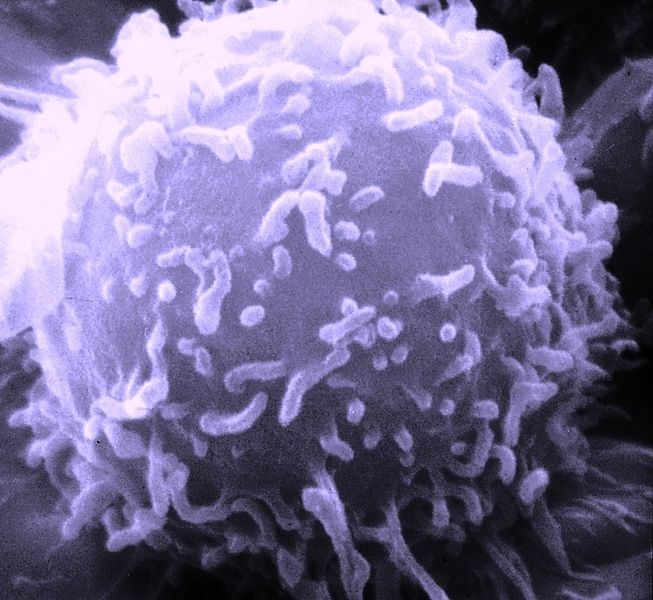

Gas produced by the body leads to differentiation of subtype Th9 lymphocytes, which produce a cytokine capable of exacerbating the inflammatory response (lymphocyte image: Wikimedia)
Gas produced by the body leads to differentiation of subtype Th9 lymphocytes, which produce a cytokine capable of exacerbating the inflammatory response.
Gas produced by the body leads to differentiation of subtype Th9 lymphocytes, which produce a cytokine capable of exacerbating the inflammatory response.

Gas produced by the body leads to differentiation of subtype Th9 lymphocytes, which produce a cytokine capable of exacerbating the inflammatory response (lymphocyte image: Wikimedia)
By Karina Toledo
Agência FAPESP – A study published in the journal Nature Communications has described the mechanisms through which nitric oxide – a gas naturally synthesized by endothelial cells, defense cells such as macrophages, and certain types of neurons – contributes to the exacerbation of allergic responses.
According to the authors, nitric oxide promotes the differentiation of a specific type of defense cell – lymphocyte T helper 9 (Th9) – responsible for secreting a substance known as interleukin-9 (IL-9), involved in allergic processes. Data from the research literature indicate that asthmatic patients show elevated levels of this cytokine in their lungs.
The investigation was conducted by researchers at the University of Glasgow in Scotland and the University of São Paulo (USP) in Ribeirão Preto. The experiments in Brazil were conducted under the purview of the Center for Research on Inflammatory Diseases, one of the Research, Innovation and Dissemination Centers (RIDCs) supported by FAPESP.
“We discovered the relationship between nitric oxide and IL-9 by accident during my post-doctoral studies in Glasgow. At the time, we were investigating the role of nitric oxide in the differentiation of Th17 cells, another lymphocyte subtype involved in autoimmune diseases,” explained Sandra Yasuyo Fukada, professor at the Ribeirão Preto School of Pharmaceutical Sciences at USP and one of the article’s authors.
Studies in vitro conducted by the group at the time demonstrated that nitric oxide was able to inhibit Th17 cell differentiation.
“Then, we used animals that were deficient in one of the enzymes that synthesize nitric oxide – NOS2 – and tested the effect of the gas on the development of experimental autoimmune encephalomyelitis (EAE). We observed that in the absence of nitric oxide, the animals presented a more severe form of the disease,” Fukada explained.
According to the researcher, the previous study had pointed to nitric oxide as a potential endogenous regulator capable of controlling complications in diseases such as multiple sclerosis. In an effort to better understand the effect of nitric oxide on Th17 lymphocytes, the group conducted large-scale gene expression analysis on these cells.
“The results showed a reduced gene expression involved with the Th17 pattern and, interestingly, an increased expression of IL-9,” explained Paula Barbim Donate, a post-doctoral candidate at the Ribeirão Preto School of Medicine (FMRP-USP) and co-author of the article.
In the current study, which included collaboration from Donate and Daniele Carvalho Nascimento of FMRP-USP, the researchers decided to investigate the role of nitric oxide in Th9 cell differentiation.
Using in vitro tests, the researchers observed that in the presence of a donor molecule of nitric oxide – NOC-18 – differentiation of CD4 T lymphocytes in Th9 was reinforced and maintained.
“Depending on the conditions of the culture medium, CD4 T cells can differentiate into specific subtypes of lymphocytes. We used the appropriate conditions for CD4 T cells to differentiate into Th9 cells. When we added the NOC-18, the percentage of CD4 T cells that polarized to Th9 increased from 28% to 70.2%,” explained Fukada.
The research group also described the intracellular mechanism through which nitric oxide works, involving the activation of specific critical transcription factors for the polarization of Th9, such as p53, STAT-5 and IRF-4, in addition to increased levels of interleukin-2 (IL-2).
Animal model
The next step was to determine the biological significance of the discovery made in vitro. Using an animal model of allergic lung inflammation, the researchers assessed whether the donor nitric oxide molecule would increase the release of IL-9 and whether this would reflect a more exacerbated inflammatory response, which in fact occurred.
In the group of animals that developed the induced allergic process, the nitric oxide donor increased the levels of IL-9 and the number of eosinophils – a type of defense cell considered to be a marker of allergy – in the bronchoalveolar lavage. This test consists of injecting sterile saline into the lung to remove and analyze lung cells.
Increased IL-9 levels were accompanied by a more exacerbated allergic condition, shown by a larger presence of mucus and inflammatory cells in the histological analyses of the lung. The researchers were able to improve the allergic conditions in the animals by treating them with anti-IL-9 antibody. The neutralization of this cytokine reversed the effect of the nitric oxide donor.
“These data show that there is in fact a relationship between nitric oxide, increased levels of IL-9 and a more exacerbated inflammatory response in the lungs. And the anti-IL-9 antibody protected the animals,” Fukada said.
Although there is already phase 2 clinical testing to evaluate the effectiveness of a medication against asthma capable of inhibiting IL-9, the role of nitric oxide in this process was still unknown.
“Our group found the connection between these two points and described the intracellular mechanisms involved in the action of nitric oxide on the increased levels of IL-9,” noted Nascimento.
The article “Nitric oxide enhances Th9 cell differentiation and airway inflammation” (doi: 10.1038/ncomms5575), can be read at: www.nature.com/ncomms/2014/140807/ncomms5575/full/ncomms5575.html.
Republish
The Agency FAPESP licenses news via Creative Commons (CC-BY-NC-ND) so that they can be republished free of charge and in a simple way by other digital or printed vehicles. Agência FAPESP must be credited as the source of the content being republished and the name of the reporter (if any) must be attributed. Using the HMTL button below allows compliance with these rules, detailed in Digital Republishing Policy FAPESP.




